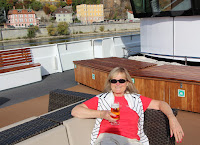 |
| The Prince Bishops palace on the hill overlooking Wurzburg simply wasn't large enough |
The riverboat was moored in Wurzburg and after our visit to Rothenburg earlier in the day, we returned to explore the city with a heavy focus on a magnificent wine cellar.
For centuries the prince bishops wielded enormous power in the region, ruling the area from their hilltop fortress. But they decided this massive structure was not big enough and a new, larger palace was constructed in the middle of town. Simply known as
"The Residenz" the building is absolutely vast and the wine cellar beneath it impressive.
Wurzburg was practically razed to the ground during World War Two fire bombing. The survival of the
Residenz’s magnificent
frescoed ceiling was largely due to the efforts of John Skilton - one of the famous
Monuments Men. The former curator of Washington DC's National Art Gallery, Skilton and his colleagues joined troops across Europe after D-Day to rescue cultural monuments stolen by the Nazis.
Wurzburg’s Residenz suffered heavily during the bombing and the roof of the central vault was destroyed leaving Tiepolo’s “Olympus and Four Continents” exposed to the elements. John Skilton led efforts to successfully salvage the painting before weather could destroy it.
 |
| Aspects of Tiepolo's "Olympus and the Four Continents" |
Turning to more convivial pursuits, a special treat was in store. Wine tasting in the former Prince Bishop’s Court Cellar underneath the
Residenz.
Staatlicher Hofkeller was
established in 1128.
 |
| Wonderful atmosphere in the Wine Cellar! Beautifully carved barrels illuminated by candlelight |
Viticulture was introduced to the Franconian region of the Main in the Middle Ages thanks to the Monks.
 |
| State of Play in the wine cellar |
The region specializes in white wines and we sampled a 2014 Horsteiner Muller-Thurgau, a 2014 Randersackerer Marsberg Silvaner and, our favourite, a 2014 Hofkeller Wurzburg Riesling.
 |
| Schneeballen - BEWARE! |
The flavourful wine had left a pleasant taste on the palate, thankfully finally putting to bed the lingering memory of the Schneeballen, a deep fried ball of shortcrust pastry rolled in sugar and cinnamon and a Rothenburg specialty tackled earlier in the day.
A little had gone a very long way!


















































